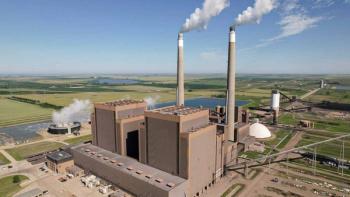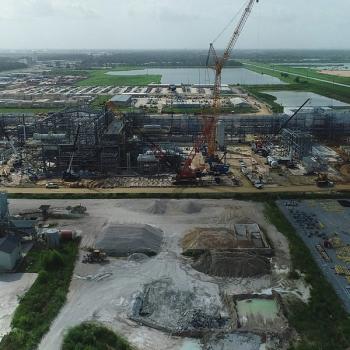
- January/February 2021
Spinning Reserve: Commonwealth Chesapeake gives LM6000s double duty
The Commonwealth Chesapeake Power Plant provides standby power to the local grid as well as offering spinning reserve availability to the region.
Turbomachinery International recently visited the Commonwealth Chesapeake Power Plant on Virginia’s Eastern Shore. Located at the edge of the town of New Church near the Virginia/Maryland border the plant consists of 7 GE LM6000 aeroderivative gas turbines.
The facility began operation in 2000 with three LM6000s, with four more on order. Each operates in simple cycle mode. A year later, the other four units were added (for a combined plant capacity of 315 MW). In the interim, though, things changed on the regional grid.
The grid operator is the PJM Interconnection regional transmission organization (RTO). PJM originally served Pennsylvania, New Jersey, and Maryland, but now also encompasses all or part of Delaware, Illinois, Indiana, Kentucky, Michigan, North Carolina, Ohio, Tennessee, West Virginia, and District of Columbia. As one of the largest competitive wholesale electricity markets in the world, it boasts 65 million customers and 180 GW of generation capacity.
PJM decided to allow the presence of generators outfitted with clutches that could disconnect from their turbines to enable them to operate as synchronous condensers and provide spinning reserve. The last GE four turbines, therefore, were fitted with clutches from SSS Clutch. These clutches required a slightly larger footprint than the original LM6000s. To allow enough clearance for the clutch between the turbine and generator, the foundation and footing had to be expanded a few feet and shaft couplings had to be added.
As a result, the plant could sell spinning reserve services to PJM. When requested, that generation capacity had to be available online. During this period, PJM pays the plant to have that power on standby. But once the power is required, it must be on the grid within 10 minutes. This enables the RTO to quickly respond to generation or transmission outages elsewhere on its network. Control software is used to bring the turbine rapidly up to near-synchronous speed in order to engage or disengage the turbine. When disengaged, the generator continues to spin (thus, the ancillary service known as spinning reserve). The revenues earned from spinning reserve paid for the clutches within a few years.
Units 4, 5, 6 and 7 were outfitted with clutches to enable these LM6000s to provide spinning reserve.[/caption]
Plant maintenance
The ownership of the plant has shifted over the years. The original owner TECO Energy sold it to Tenaska Capital Management who, in turn, sold it to Tyr Energy in 2008. Tyr Energy brought in NAES to operate and maintain the facility. A total of eight operators are involved, split in to four teams to cover all shifts and allow for time off. Four employees remain from the team that began in 2000, one of which is Paul Bernard, Operations & Maintenance (O&M) Manager at the Commonwealth Chesapeake Plant.
“As we are a spinning reserve site, we have to maintain 24-hour coverage,” said Bernard.
He explained that turbines 1, 2, and 3 are direct coupled to the generator and are only used for power generation when required. Units 4 to 7 with clutches are fired up if assigned in the spinning market. He said their mode of operation has changed little over the last twenty years.
The grid on the Eastern Shore’s lower peninsula doesn’t have to serve a large population. However, in the event of grid maintenance, the Commonwealth Chesapeake facility might have to power the entire lower peninsula of Virginia.
As well as the turbines, Bernard and his team look after inlet air chillers, demineralized water and raw water chemical injection skids, and a lube oil storage locker. The facility is currently working with the county to reduce well water usage as part of NOx control. Although it does not utilize potable water onsite, groundwater is always under consideration in the area.
One of the duties of the team is ensuring the supply of liquid fuel for the turbines. Ultra-low sulfur diesel fuel has to be trucked onsite. Dozens of tankers per day would be required if all seven turbines were asked to run simultaneously. These tankers travel two hours south on Route 13 from northern Delaware/Southeast Pennsylvania refineries. As well as being expensive, it opens the door to safety issues and adds to the carbon footprint of the plant. A natural gas pipeline would be a more environmentally sensible solution.
Pre-dating the construction of the plant, there have been discussions about bringing a natural gas pipeline to the area that could provide fuel for the site. Such talks have continued sporadically and progress appeared to have been made recently in bringing a natural gas pipeline down the peninsula into Somerset County, one of the poorest areas of Maryland. A license was recently granted to enable drilling under a river to feed a pipeline further south. If that work moves forward, that could take a pipeline within a few miles of the Commonwealth Chesapeake Power Plant. It seems unlikely that such a pipeline would fail to tie into the plant.
The Commonwealth Chesapeake Power Plant is maintained by an operations and maintenance team provided by NAES.[/caption]
Upgrades?
GE offers a wide variety of upgrades for the LM6000. These include improved combustors, fans, fire protection panels, controls, fast start technology, repowers, asset performance management, and more. With a close eye on maintaining profitability, Commonwealth Chesapeake has not seen the need to make major changes to its seven turbines.
“We’ve kept up with the service bulletins issued by GE, but no major enhancements have been implemented,” said Bernard.
SPRINT (SPray INTercooling) was considered as a way to increase the power output of the LM6000 gas turbine. By cooling the combustion air, greater mass flow travels through the Low Pressure Compressor (LPC) and the High Pressure Compressor (HPC). However, that would have raised water usage. In any case, the existing chillers were deemed sufficient. Similarly, Bernard said that there is no need to add clutches to the other three units. Four, he said, are enough to meet spinning reserve requirements.
Turbine operation is cyclic, largely dependent on regional weather conditions. He said the presence of an approaching cold front, for example, may see anywhere from one to all seven units called upon to provide power.
Maintenance for the site as a whole is minimal. The O&M Manager said the SSS clutches have proven to be robust and are running well with no significant issues experienced over their two decades of operation. External and internal inspections are conducted in the spring and fall.
His advice to others contemplating the spinning reserve market is to retrofit the turbines with clutches to ensure the turbines are constantly available when needed. He said that it is common to receive notice to be available within an hour. Units have to be synchronized in that time. And online in a spinning reserve state with the turbine offline.
“From that moment on, if we have a PJM spin event, we have 10 minutes to get to baseload for turbines,” said Bernard. “If another unit somewhere else trips, they bring us online.”
The footprint had to be expanded by several feet to allow enough space for the SSS clutch to be positioned between the turbine and the generator.[/caption]
Aging turbines
The Commonwealth Chesapeake Power Plant on Virginia’s Eastern Shore may serve as a model on what utilities can do with aging gas turbine plants. With politicians, grid operators, and utilities being subjected to propaganda about the perils of fossil fuels, some are considering shuttering these facilities and replacing them with wind, solar, or battery storage. Those following that course may live to regret any haste in divesting rotating assets.
Older gas turbines have an important role to play in maintaining grid stability and inertia, providing reactive power, and in markets like PJM, providing spinning reserve as an ancillary service. These units can provide standby power where needed, and otherwise can offer the synchronous condensing and spinning reserve services that are likely to be in high demand as a greater percentage of renewable assets come online. ■
Articles in this issue
over 4 years ago
Why some turbomachinery applications need expansion jointsalmost 5 years ago
Assessing asset life cycle, condition, reliability, and performancealmost 5 years ago
Condition monitoring of steam turbine generator governing systemsalmost 5 years ago
Myth: Compressor bearing temperature must be below 200°Falmost 5 years ago
Q&A: Should you use a black box or an open controller?almost 5 years ago
Vendor Spotlight: Kobe Steelalmost 5 years ago
Software expands turbomachinery capabilitiesalmost 5 years ago
It's been quite a decadealmost 5 years ago
What we learned at the virtual Turbomachinery SymposiumNewsletter
Power your knowledge with the latest in turbine technology, engineering advances, and energy solutions—subscribe to Turbomachinery International today.




